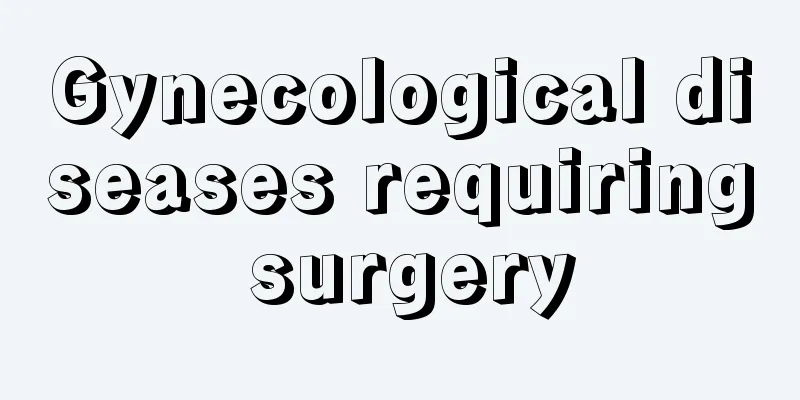Gynecological diseases requiring surgery

|
Gynecological diseases have always troubled women's physical and mental health, and severe cases can even affect women's fertility. Therefore, gynecological diseases are receiving more and more attention. There are many kinds of gynecological diseases, such as cervical erosion, cervical cancer, ectopic pregnancy, uterine fibroids, etc. Some diseases require surgical treatment, while some minor diseases can be cured by taking anti-inflammatory drugs. So in daily life, which gynecological diseases require surgical treatment? Let’s find out below. Treatment method 1. Hysteroscopy originated in 1869 and is also called uterus endoscopy. With the rapid development of science and technology, hysteroscopy is currently divided into panoramic hysteroscopy, contact hysteroscopy and microhystero-colposcope. The method of using a hysteroscope is to start the perfusion system to expand the uterus before the operation. This can ensure the intrauterine pressure and also have the effect of cooling and flushing. Hysteroscopy is divided into inspection hysteroscopy and surgical hysteroscopy. There are three different types of electrodes in surgical hysteroscopes, and their normal operation depends on the support of the energy system, that is, electric current. Treatment method 2: In order to ensure the accuracy of the operation, a light source system and an imaging system are also needed to help. During the operation, clear lighting and monitoring of the imaging system can avoid unclear vision and play a guiding role. Hysteroscopy can not only determine the location, size, appearance and range of the lesion, but also make detailed observations of the tissue structure on the surface of the lesion, and obtain samples or perform positioning curettage under direct vision, which greatly improves the accuracy of diagnosis of intrauterine diseases, updates, develops and makes up for the shortcomings of traditional diagnosis and treatment methods. Indications for hysteroscopic treatment include: uterine bleeding such as menorrhagia, frequent menstruation, prolonged menstruation, irregular uterine bleeding, dysfunctional uterine bleeding, submucosal fibroids, endometrial polyps, infertility and recurrent spontaneous abortion; abnormal or suspicious conditions indicated by B-ultrasound, hysterosalpingography or curettage, which can be confirmed, verified or excluded by hysteroscopy; adhesions in the uterine cavity or residual foreign bodies in the uterine cavity, the latter including fetal bone fragments, etc.; suspected endometrial cancer and its precancerous lesions, the use of hysteroscopy, positioning biopsy combined with histopathological evaluation is helpful for early diagnosis and timely treatment; if the patient is suitable and well prepared before surgery, some hysteroscopic surgeries can replace or improve traditional treatment methods. Treatment method three: Compared with open surgery, vaginal gynecological surgery has the advantages of no incision on the abdominal wall, less damage, quick recovery, short hospitalization time, low hospitalization costs, and easy acceptance by patients, which fully demonstrates the advantages of minimally invasive surgery. Some foreign experts believe that: "Under the same conditions, if vaginal surgery can be performed, it should be performed as much as possible. With the proficiency of vaginal surgery and the development of special surgical instruments, the indications for surgery are constantly expanding. There are reports that large non-prolapsed hysterectomies can be performed at 12-16 weeks of pregnancy, so it has been favored by some gynecologists. However, this method is difficult to treat uterine fibroids that retain the uterus (except submucosal fibroids that prolapse from the cervical os), and the cervix cannot be retained. The surgical operation has certain technical difficulties. For example, if the fibroids are too large to be removed from the vagina, pelvic adhesions, adnexal lesions, a history of lower abdominal surgery, and vaginal stenosis all increase the difficulty of surgery, increase the chance of damaging the bladder and rectum, or change the surgical method, which makes this procedure limited. |
<<: What are the reactions before your period comes?
>>: Is it normal for my period to end in three days?
Recommend
YouGov: 65% of Indians plan to replace TikTok app
YouGov's latest survey shows that in the abse...
Pharmacist's Antidote | Aspirin also has its imperfections and is prohibited for patients with gastrointestinal ulcers and asthma!
Spanish thinker Ortega y Gasset once said: "...
Do cats need to be dewormed regularly? How do cats usually deworm?
As we all know, cats are very prone to breeding b...
Have fun eating and playing during the Chinese New Year, but be careful about children's indigestion
Have fun eating and playing during the Chinese Ne...
What is the best way to get rid of dampness and toxins in women?
Women are more likely to have symptoms of cold bo...
How to avoid pregnancy after sex
If you want to prevent yourself from getting preg...
Is gynecological red light therapy effective?
Gynecological diseases may cause excessive vagina...
The difference between backache before menstruation and backache during pregnancy
The symptoms of back pain before menstruation and...
The steps of painless abortion
There is no doubt that every adult man and woman ...
The cervical cyst disappeared after half a year
Some people do not need treatment for cervical cy...
How to quickly relieve pain in pregnant women with wisdom tooth inflammation
I believe that the problem of wisdom tooth inflam...
[Healthy Life] Tianjin pediatric experts remind: If your child has this condition, you should seek medical attention immediately!
This year Compared with previous years, the influ...
Why do we need to use azithromycin for 3 days and stop for 4 days? Will it weaken the efficacy of the drug?
A friend consulted Huazi. When he was taking azit...
What happened if my period is delayed for more than 10 days?
Women's menstruation often changes. For examp...
Diarrhea at 4 months of pregnancy
After pregnancy, you become the key protected per...









